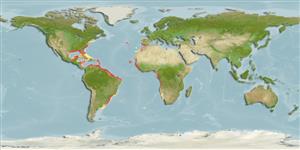Common names from other countries
Environment: milieu / climate zone / depth range / distribution range
Ecologia
marinhas; estuarina; intervalo de profundidade 10 - 180 m (Ref. 27121). Subtropical; 44°N - 40°S, 97°W - 16°E
Western Atlantic: New England, USA and Bermuda to Argentina (Ref. 47377). Eastern Atlantic: Mauritania to Namibia (Ref. 27121). Southwest Atlantic: Sergipe, Brazil (Ref. 118626).
Tamanho / Peso / Idade
Maturity: Lm ? range ? - ? cm
Max length : 100.0 cm TL macho/indeterminado; (Ref. 3694); common length : 60.0 cm TL macho/indeterminado; (Ref. 3694); peso máx. Publicado: 4.9 kg (Ref. 40637)
Espinhos dorsais (total) : 0; Raios dorsais moles (total) : 13 - 15; Espinhos anais: 0; Raios anais moles: 12 - 13.
Inhabits inshore and near-shore areas, over sand or mud bottoms. Usually found alone or in small, loose aggregates. Adults are pelagic, but near continental margins; young are commonly found on coastal and offshore banks (Ref. 7251). Feeds on fish and shrimps (Ref. 28587). Minimum depth from Ref. 26912. Its flesh is very delicate; nevertheless, in certain region like the Pacific and the Indian Ocean, it is toxic (particularly the skin and the viscera) (Ref. 5377). Poisonous, should not be eaten (Ref. 36731).
Life cycle and mating behavior
Maturities | Reprodução | Spawnings | Egg(s) | Fecundities | Larvas
Shipp, R.L., 1990. Tetraodontidae. p. 1069-1072. In J.C. Quero, J.C. Hureau, C. Karrer, A. Post and L. Saldanha (eds.) Check-list of the fishes of the eastern tropical Atlantic (CLOFETA). JNICT, Lisbon; SEI, Paris; and UNESCO, Paris. Vol. 2. (Ref. 7464)
Categoria na Lista Vermelha da IUCN (Ref. 130435)
CITES (Ref. 128078)
Not Evaluated
Utilização humana
Pescarias: pouco comercial
Ferramentas
Relatórios especiais
Descarregue XML
Fontes da internet
Estimates based on models
Preferred temperature (Ref.
115969): 16.2 - 27.3, mean 23.2 (based on 373 cells).
Phylogenetic diversity index (Ref.
82804): PD
50 = 0.5005 [Uniqueness, from 0.5 = low to 2.0 = high].
Bayesian length-weight: a=0.02042 (0.01592 - 0.02619), b=2.85 (2.81 - 2.89), in cm Total Length, based on LWR estimates for this species (Ref.
93245).
Nível Trófico (Ref.
69278): 4.0 ±0.69 se; based on food items.
Resiliência (Ref.
120179): Médio, tempo mínimo de duplicação da população 1,4 - 4,4 anos (Preliminary K or Fecundity.).
Fishing Vulnerability (Ref.
59153): High vulnerability (60 of 100).
